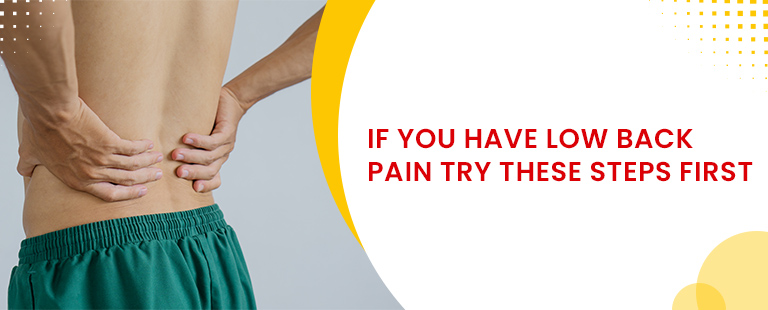Lower back pain is a lifestyle disease affecting millions of people across the globe. The causes of low back pain can be an injury, overuse of the spine, improper sitting posture or chronic conditions such as arthritis or spinal stenosis. No matter the causes of low back pain, it causes immense pain and uneasiness affecting the quality of life.
If you are suffering from pain and looking for some back pain management tips, we are here to help you:
- Exercises: Regular physical activity is one of the best ways to treat lower back pain treatment. General cardio, such as running, walking, and swimming, would deliver significant results and reduce the load on your lower back. Stretches for lower back pain in pilates and yoga which focuses on strengthening the muscles, would help to improve the posture and build stronger back muscles to support you. Have a chat with your doctor about the kind of lower back pain exercises best suited for you. Start slowly and build strength gradually.
- Over-the-counter medicines: Over-the-counter medications can give you some momentary back pain relief. Consult your doctor about medicines you take for back pain relief and follow all their instructions.
- Heat or cold compress: Heat and a cold compress for low back pain treatment are effective methods. The hot pad or shower would help relax the muscles, whereas the cold shower or compress would reduce swelling and decrease blood flow in that area. Use both for back pain relief, and find out which works best for you. Also, do not apply direct heat or ice onto your skin.
- Massage therapy: Lower back pain massage can help better blood circulation and aid in the relaxation of the muscles. While looking for lower back pain exercises and massage, choose a certified therapist who has treated others with low back pain. Discuss your condition beforehand with the therapist and what you expect from the therapy.
- Chiropractic care: Chiropractic therapy is focused on reaching musculoskeletal problems through lower back pain exercises, manual therapy and other modes to give back pain relief. It is done by physically moving the spine and related joints to reduce pain and improve motion. Search for an experienced chiropractor who will assess your conditions and develop a customised plan accordingly. Usually, lower back pain exercises include spinal manipulation done by the chiropractor with their hands. They choose a specific part of the spine and apply pressure to align them correctly. Other techniques, such as soft tissue therapy and manual lower back pain therapy, reduce the pain and enhance movement.
- Medications: If the prescription lower back pain medications are not working well, the doctor will give you stronger medications such as opioids and muscle relaxers. Make sure to thoroughly discuss their impact and follow all the instructions to avoid any side effects.
- Lifestyle changes: Having an active lifestyle with the ideal body weight reduces the extra pressure on the back. It is one of the most effective natural remedies for low back pain. Smoking is one of the causes of low back pain. It causes constriction of the blood vessels and can lead to spinal disc degeneration. Quitting smoking can show improvement in many aspects of health.
- Physical therapy: Physical therapy steps work on musculoskeletal problems. It includes stretches for lower back pain and therapy to reduce back pain. A customised plan would be designed for you to get relief from your pain and increase mobility. They would also give you lessons on how to maintain the right posture. Always ensure the physical therapist is certified and trained to get the best results.
A good posture is an effective low back pain treatment. Using the phone continuously in a hunched position can increase the stress on the lower back. Always look for a chair which supports the natural curve of your spine. Position your screen, so you don’t have to bend to look at it.
Also, avoid activities which cause higher stress on your lower back. For instance, while lifting heavy objects, ensure the correct posture to avoid strain on your lower back.
Consult with a specialist about effective lower back pain treatment. Book your appointment now at Germanten Hospital for one of the best treatments.






